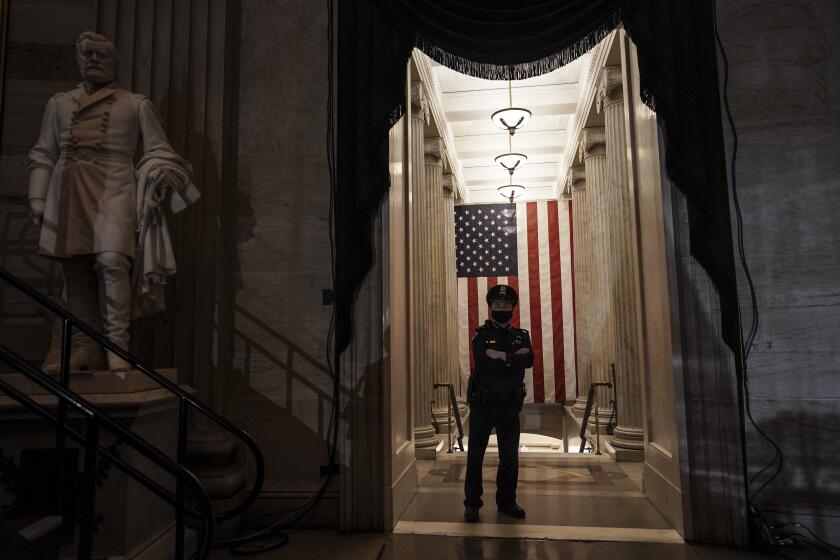Threats against members of Congress are skyrocketing. It’s changing the job

- Share via
WASHINGTON — A few months ago, Rep. Norma Torres (D-Pomona) received an anonymous video of someone following her car. The camera pans down to a 9-millimeter handgun on the seat as a male voice says: “I see you. I got something for you.”
In June, police charged a man with making “terroristic threats” against Rep. Tom Reed (R-N.Y.). The man left on the congressman’s doorstep a dead rat with a noose around its neck and a brick with a family member’s name.
Police intervened in January when more than a dozen supporters of then-President Trump confronted, surrounded and threatened Rep. Lou Correa (D-Santa Ana) as he was catching a flight at a Washington airport.
In a year that kicked off with the deadly Jan. 6 attack on the U.S. Capitol, threats against lawmakers are soaring. In the first three months of 2021, the U.S. Capitol Police recorded 4,135 threats against members of Congress. If that pace continues, total threats this year will double those in 2020.
It’s a trend that has been growing for years, and Capitol Police officers are scrambling to keep pace. They’re rethinking the ways they protect members in Washington and elsewhere, forging closer ties with the FBI and opening satellite offices outside the capital for the first time.
It’s changing the job for lawmakers, who must tread a fine line between being accessible to the people they represent and keeping themselves, their families and their staffs safe. After Jan. 6, some members temporarily relocated their families over concerns that their homes would be targeted. Some wore bulletproof vests to the presidential inauguration.
“It’s difficult, and particularly difficult for the family,” said Rep. John Garamendi (D-Walnut Grove), who as state legislator once had a gun pointed at him during a town hall. “There are risks in this job. There’s no doubt about it. We spend millions of dollars to let everybody know who we are. So you become a target.”
Experts blame much of the increase on social media and cable news, and how easy it has become to threaten members of Congress behind the anonymity of the internet.
Four years of Trump’s divisive and racist rhetoric played a role, they say, emboldening people to say things publicly that they might have grumbled about privately in the past.
It’s also a side effect of growing partisanship and declining civility. Members have contributed to the problem by sometimes encouraging their supporters to harass political rivals. And activists find it more acceptable to confront lawmakers, not just at town halls but at the officials’ homes or as they eat in restaurants.
Some threats have escalated into violent physical attacks.
Before Jan. 6, there was the 2017 shooting of Republican members of Congress and staffers at a practice for the Congressional Baseball Game, and the 2011 shooting of Arizona Rep. Gabrielle Giffords at a constituent event.
The surge in threats has grown exponentially in recent years. In 2016, Capitol Police investigated 902 threats, former House Sergeant at Arms Paul Irving said in a June 2017 letter to the Federal Election Commission. By 2018, there were 5,206 threats, and by 2020, there were 8,613, according to Capitol Police figures provided to The Times.
Capitol Police officials declined interview requests. Many members of Congress don’t discuss the threats publicly; dozens declined requests to speak about their security.
Just tallying, monitoring and investigating the threats has become more difficult for the Capitol Police, which doesn’t have the staffing to give all 435 representatives and 100 senators a security detail or to monitor their social media accounts.
In May, the department’s inspector general recommended increasing intelligence gathering and surveillance, including creating a division staffed with analysts, agents and officers, as well as hiring more agents in the Threat Assessment Section. It also urged Capitol Police to work more closely with the FBI to examine threats.
In 2020, the Threat Assessment Section had just over 30 agents and analysts to examine approximately 9,000 cases, according to its response to the May watchdog report.
In July, Capitol Police announced plans to open satellite offices to help monitor potential threats, starting in Northern California and Florida, the states from which the bulk of the threats come, the department says.
Among the billions Congress recently passed to repay the National Guard for protecting the Capitol after Jan. 6 was $47.8 million for member security and for examining threats, including $5.8 million for new security details; $35.4 million to reimburse and train federal and local law enforcement agencies that help protect members; and $6.6 million to hire and train additional agents to gather intelligence about potential threats.
Capitol Police announce they are opening two satellite offices to protect members of Congress while they are not in Washington.
Members of Congress are hoping the new offices and funding will allow Capitol Police to take on more of the burden of identifying threats and deciding who is serious and who might just be venting anger online.
Garamendi, the chair of the House Armed Services Readiness Subcommittee, said Capitol Police officers are quick to respond to threats they know about but don’t have the resources for intelligence gathering and surveillance.
“Intelligence, as it applies to us individually, it just isn’t there. The normal way is: We get a threat, and then we inform the Capitol Police or the FBI, ‘Hey, we got this threat; why don’t you look into it?’ And they do, and they do a good job,” he said. “But the intelligence — anticipating — it’s not there.”
Rep. Eric Swalwell (D-Dublin) said a staffer spends hours combing his social media accounts for threats that warrant being forwarded to Capitol Police every time Trump mentions his name online or at a rally.
“My rule is, you have to take them at their word, even if a lot of them may not mean it. The second you don’t take them at their word is the second you could see someone in your family hurt,” Swalwell said.
Dozens of cases of people threatening to kill Democratic and Republican lawmakers have been brought in federal court in the last five years. Threatening a federal official is a felony punishable by a fine and up to six years in prison.
Rep. Andy Harris (R-Md.) for months carried a concealed weapon and scanned the street before leaving his home, after a man called and emailed in December saying he was going to slit the congressman’s throat, skin him alive and kill his family.
“You’d be worried about any car that stopped in front of the house on the street,” Harris said. “My family felt like prisoners in their own home.”
This month, the man was convicted and sentenced to weekend jail time, two years of probation and six months of home detention.
Harris said he embraces differences of opinion, but “this person didn’t call my office to complain about a policy. He called my office, threatened me and my family’s life, because of a policy issue.”
Reed once played down the threats. But not after someone targeted his children.
“It traumatized my kids,” Reed said of the dead rat and brick left on his doorstep. “I don’t discount the threats like I used to. You can’t disregard it. You have to recognize it is part of the job.”
Since Jan. 6, more than 100 members have reported spending thousands of dollars each in campaign funds to install security systems and hire bodyguards for public events, according to federal election forms. A few have gotten permits to carry concealed weapons either at home or in Washington.
Some said they’re more likely to remove the pin identifying them as a member of Congress as they leave the heavily fortified Capitol complex; many dress down on flights, wearing sweatpants and hoodies to avoid drawing attention.
They’ve insisted on additional emergency training for themselves and their staffs after the confusion and terror of Jan. 6 left members fumbling to open gas masks they didn’t even know were under their seats. Staffers huddled in locked offices were unsure whether to flee, or to where.
Swalwell said this year was the first time he paused before bringing his two young children to a constituent event.
“I still took them, because I wanted to show that we’re not going to be bullied out of them being a part of my work in some meaningful way,” he said.
Many of the highest-profile members of the California delegation have been shadowed by Capitol Police on and off for the last few years or have seen people convicted for making threats against them. Four men are serving prison time for threatening to kill Rep. Maxine Waters (D-Los Angeles) since 2018.
At home in their districts, most members of Congress primarily rely on local police.
Torres was subject to a torrent of online and in-person threats after arguing with El Salvador President Nayib Bukele this spring.
When multiple men appeared outside her home, flashing gang signs and trying to engage her husband in a fight, Torres scared them off with a gun. It took local police hours to arrive. The threats were so severe that Capitol Police officers spent five days living in her home.
Torres moved out of her Washington apartment in the basement of a house and into a high-rise building with 24-hour security.
“I just don’t feel safe anymore,” she said.
More to Read
Get the L.A. Times Politics newsletter
Deeply reported insights into legislation, politics and policy from Sacramento, Washington and beyond. In your inbox three times per week.
You may occasionally receive promotional content from the Los Angeles Times.












